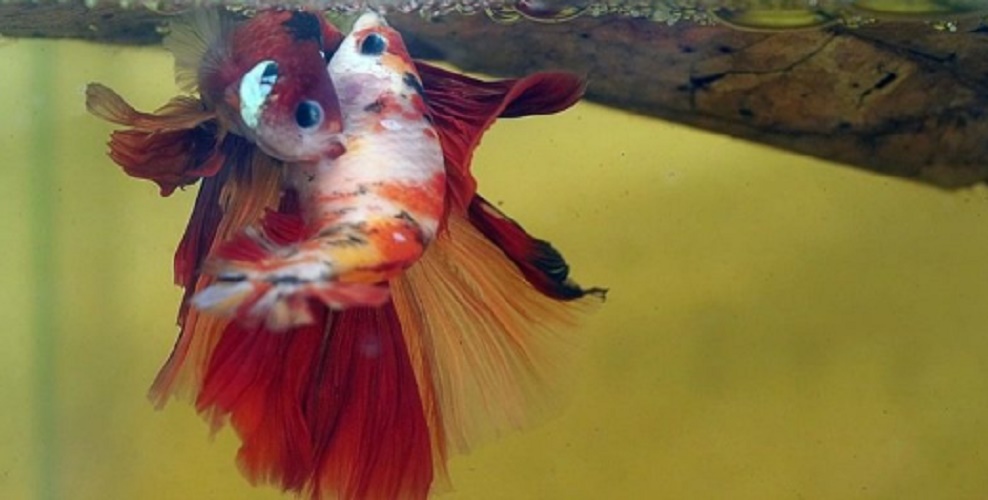How do fish reproduce?
We explain how do fish reproduce an oviparous, viviparous and ovoviviparous and other manner. In addition, what are reproductive migrations with breeding period and season. so lets read that How do fish reproduce?
How do fish reproduce?
Fish are marine , abundant and diverse vertebrate animals in the different oceans , lakes and rivers of our planet . Many of them are part of the diet of humanity, while others may become companion animals.
These are species of eukaryotic animals. They breathe through gills and are equipped with fins instead of legs , distributed differently throughout their bodies.
Fish are only a fraction of the aquatic animals that exist, that is, they are immersed in complicated dynamics of predation and competition . Therefore, the reproduction of fish is not an ecologically simple matter.
In reproduction, courtship strategies are common to attract the female , such as dances, nest fabrications, etc. In addition, different species developed diverse methods to guarantee the perpetuity of the species .
The reproduction is almost always sexual , since fish, as the great common of animals are born with a certain (female-male) sex. In general, it occurs in three different ways: oviparous, viviparous and ovoviviparous. We will see each of them below.
Types of fish reproduction

As we said before, fish reproduce in three different ways, depending on the specific species we are talking about. These modes are:
- Oviparous reproduction . As the name implies, it is about reproduction by eggs, which is most common in the species of fish that exist. This usually occurs through external fertilization strategies, that is, the female lays her eggs in the environment and then the male fertilizes them with her sperm. There are also rare cases in which eggs are fertilized within the female through intercourse.
- Viviparous reproduction . This type of reproduction, similar to that of human beings, implies the internal fertilization of the female, the maturation of the breeding in its interior thanks toplacental nutrition and then its expulsion through a birth canal, ready to start Yourindependent life . Only about 53 families (around 900 species) of fish have this type of reproduction, which has the evolutionary advantage of ensuring that the offspring leave the world as mature as possible.
- Ovoviviparous reproduction . This is a method of reproduction that combines the previous two in a certain way: the female lays eggs inside, which are fertilized internally by the male during intercourse. Juvenile specimens grow inside these eggs, without the need for maternal placentas, until they are ready to hatch the eggs. Only then does the female deposit them in the environment, or even expel them into the water around her moments before or after birth.
Hermaphroditism of the fish

In the vast majority of cases, fish have separate and well defined sexes. However, there are species in which hermaphroditism is common , that is, they have both sexes or alternate between them in some state of their sexual maturation.
Some species, for example, grow like females and at some point in their adult life they “change sex” (proteroginic species), so to speak, or vice versa (proterrandic species). In contrast, simultaneous hermaphroditism, in which an individual has both functional sexes at the same time, is extremely rare in vertebrate animals.
Did you know that hermaphrodite fish exist?
Explaining how fish reproduce in the case of hermaphrodites is an interesting and enjoyable process, since hermaphrodites do not have a specific sex and can become female or male at will depending on the need for mating. This is known as simultaneous hermaphroditism.
However, there is another type of hermaphroditism in which fish are male for the first part of their life, and then become female . This is called protandric hermaphroditism, while the opposite (first female and then male) is called protogenic hermaphroditism.
Fish breeding migrations

Migratory species are those that make long trips or trips with the sole purpose of reproduction or spawning . Some even alternate between fresh and salt water in this movement, which they would not normally do in their daily lives.
The classic example is salmon , a sea fish that once reached sexual maturation, traces the rivers upstream to reach its usual places of spawning. This difficult displacement is done by jumping upstream, an opportunity that many of its predators on land take advantage of to seize their prey.
Fish territorialism
For the nesting species it is essential to defend the territory. Some species show a very pronounced territorialism, like many angelfish. Adult males defend their territory and do not allow entry to any other males. For this reason, it is common for juvenile angelfish to have another livery, that is, a different coloration. In this way the territorial males allow other young males to be in their same territory. By the time these youngsters reach sexual maturity and adopt adult coloration, they will have to find a new territory where they can attract females and have offspring .
Typical coloration of juveniles of various species of angelfish.
Change color
There are species that present different liveries throughout their development , such as the student ( Chromis chromis ), which in the juvenile stage shows an electric blue color and when they are adults they adopt a dark coloration. The trumpeter ( Macroramphosus scolopax ) lives in coastal areas between 50 and 150 meters, its color is reddish, a color that serves as a camouflage in depth. The young, however, are pelagic and to be able to camouflage themselves on the high seas, they wear a blue color with a silver belly.
Some fish, such as julia ( Coris julis ), green fish ( Thalassoma pavo), as well as many wrasses, have sexual dichromatism. Males and females are externally distinguished as they display different colored liveries. Males usually wear more striking colors to attract females.
How do fish reproduce in the aquarium?
If we want to increase the family in our aquarium we must take into account the following considerations:
- Obviously, we must be clear about how the fish in our aquarium reproduce.
- It is important to know that some fish will present sexual dimorphism , that is, males and females have different colors or sizes, which helps to differentiate them.
- Other fish will be hermaphroditic , they can behave as males or females indistinctly, they can reach sexual maturity as females and become males or vice versa.
- Depending on the reproductive characteristics of our fish, this is how we must arrange the space. For example, if they are fish that spawn on rocks, they should have them at their disposal.
- You have to count on that in some cases the newborn fry will have to be separated , as their parents or the other fish could eat them.
- Likewise, it is important that we reproduce the ideal conditions of their habitat. The temperature, pH, cleaning and oxygenation of the water or food must be suitable.
- Having a group of fish promotes successful breeding.
- The feeding must be sufficient. Be careful with overfeeding, as it could make us think that a female is pregnant. We will also have to take special care of the feeding of the fry.
- We must pay close attention to our aquarium since some females may have come to us fertilized, as is the case with guppies.
Finally, in this section we will explain how the fish best known to children reproduce, the clown fish popularized by Nemo. As we have already said, it is essential that we have an aquarium with the ideal characteristics for the species. Clownfish are oviparous and hermaphroditic . They present a laying ritual and this is more common in the spring.
When it comes to reproducing, which happens at approximately 2 years of age, the most dominant fish, generally the largest, will be the female . They will stick their orange capsule-shaped eggs on plants, rocks or a simple pot. Shortly before putting them on, we can see the wider female and both of them clean their environment. The males are in charge of their care and we will see them swimming around them, moving their fins to oxygenate the water. Their color will change and they will hatch in 7-10 days , at sunset.
The fry will consume live food and it is good to move them to another well-conditioned aquarium to prevent them from being eaten. Eggs can be moved. This is the stage that presents the greatest difficulty. Low light and a diet based on rotifer and brine shrimp are recommended . Both for this aspect and for any related to the care of these animals, we must always consult with experts. Finally, if we want to raise these fish at home, we must ensure that the specimens have not been caught in the sea to preserve the environment.
Breeding period
During spawning periods, it is difficult to distinguish between males and females, in fact some fish have the ability to change sex during their life as do the hawkfish or even the clownfish. . This phenomenon is called successive hermaphroditism . These sex changes significantly improve the chances of reproduction in fish.
Indeed the genitals of fish are located under their abdominal cavity, they are found in the same location in females and in males. In addition, their mass can sometimes represent a third of the total mass of the fish. During this period, we can observe the appearance of nuptial pimples on the head and gills of fish. Some species have a seasonal mode of reproduction, that is, their reproductive period varies with the seasons, while other species have mature and fertile ovaries throughout the year. Reproduction can only take place if there is sexual maturity of the fish.
Breeding seasons
Some species of fish reproduce two or three times a year to regenerate their offspring more easily. Spawners therefore choose a particular season and only reproduce during this period; however, they can spawn several times during this period. This is the case with Tilapia, which spawns all year round. The development of the gonadstherefore only takes place up to a certain stage, after which the sex glands remain at rest until favorable environmental conditions arise. The resting phase of the sex glands can last for several months. The arrival of the appropriate season then triggers the restart of gonadal development which ends with reproduction. Once this last phase has started, the development of the eggs cannot stop or regress. If the environmental conditions are not good enough to cause the final development of the eggs, the dormant phase continues until one of the environmental factors, oxygen or temperature for example, improves. If any of the factors worsen, the eggs begin the resorption process. The fish then has no chance of spawning that year.
In the wild, it often happens that the spawning of mature fish is abortive. If a river spawner evolves in a closed water environment, the latter’s gonads only develop up to a certain stage and thus remain dormant until resorption. It is a process that can be repeated every year without ever leading to spawning. In these fish, however, reproduction can take place by artificial induction of ovulation at the appropriate time. After laying, new eggs begin to form immediately and continue to develop until the dormant phase. By using artificial induction of ovulation, this same fish, which is a seasonal spawner, can reproduce two to three times a year.
Most freshwater fish spawn in the spring, others during flooding when water levels rise in rivers and lakes. Tropical and subtropical fish spawn during the rainy season, when spawning is most likely to survive in murky waters and fast currents.
Spawning Table
| Family | Species | Country / region of breeding | Spawning mode |
|---|---|---|---|
| Acipenseridae | Hybrid of Huso huso (Huso huso (beluga) and Acipenser ruthenus (Sturgeon sterlet)) | Russia and Eastern Europe / Rivers | Can be artificially propagated |
| Chanidae | Chanos chanos (Milkfish) | India and Far East / Sea of the region | No particular mode |
| Plecoglossidae | Plecoglossus altivelis (Ayu) | Japan / Seas and fresh waters | Breeds in lower parts of rivers |
| Coregonidae | Coregenus peled (Peled, “Syrok”) | Russia / Siberian lakes and rivers | Breeds in winter in deep water lakes |
| Coregonus lavaretus (lavaret) | Czechoslovakia | ||
| Coregonus marena | Breeds in winter in deep water lakes | ||
| Anguillidae | Anguilla anguilla (Common eel) | Europe / Coastal waters; streams and lakes | Breeds at sea |
| Anguilla japonica (Japanese eel) | Japan and China | ||
| Characidae | Colossoma | Venezuela, Colombia, Peru, Ecuador and Brazil / Amazon Basin | Breeds in rivers |
| Mylossoma | |||
| Brycon | |||
| Anastomidae | Leporinus copelandi (Piava) and other species | South America / Rivers | |
| Citharinidae | Citharidium | Breeds in streams | |
| Citharinus | |||
| Distichodus | |||
| Catastomids | Catostomus Commersonii ( sucker cyprin or North American carp) | North America | Breeds in river; spring spawning in shallow water |
| Ictiobus bubalus (small mouth buffalo fish) | United States | Reproduction on aquatic plants submerged in flooded land | |
| Ictiobus cyprinellus (buffalo fish with big mouth) | |||
| Ictiobus Niger (black buffalo) | |||
| Cyprinidae | Cyprinus carpio (common carp) | Whole world | Reproduction on aquatic plants submerged in freshly flooded ground or in ponds |
| Ctenopharyngodon idella (Chinese carp) | Siberia and China | No particular mode | |
| Hypophthalmichthys molitrix (silver carp) | Breeds in rivers | ||
| Aristichthy nobilis ( bighead carp) | |||
| Mylopharyngodon piceus (black carp) | Malaysia / Vietnam / Thailand / Japan | ||
| Cirrhinus molitorella (mud carp) | China / Taiwan / Thailand / Malaysia | ||
| Megalobrama amblicephala ( Wuchan’s bream) | China / rivers | ||
| Parabramis pekinensis (White amour bream) | |||
| Catla catla (catla) | Bangladesh / India / Pakistan / Burma / Nepal / Malaysia and other Far Eastern countries / rivers | Reproduction in flooded areas | |
| Labeo rohita (rohu) | |||
| Currhinus mrigala (mrigal) | |||
| Labeo calbasu (kalbasu) | |||
| Puntius ( Puntius javanicus , Puntius gonionotus , Puntius carnaticus ; Puntius belinka ; Puntius Ophoïdes and Puntius schwanefeldi ) | Indonesia / Malaysia / Thailand / India / river and freshwater bodies | Some species reproduce in rivers, others also in ponds, can be artificially reproduced | |
| Tinca tinca (tench) | Europe / India / Indonesia / Japan / Australia | Breeds in ponds, can be artificially propagated | |
| Tor tor (mahseer) | India | Breeds in rivers and can be artificially propagated | |
| Osteochilus hasselti (nilem) | Indonesia / Malaysia / Thailand | Breeds in lakes and rivers | |
| Siluridae | Silurus glanis (large catfish, or glean, from Central Europe) | Europe / Danube basin | Reproduces in closed waters and artificially |
| Ictaluridae | Ictalurus punctatus (spotted ictalure) | United States and Central American countries | Breeds in flooded areas |
| Claridae | Clarias batrachus (magur) | Thailand / India / Pakistan / Malaysia and Vietnam | Breeds in closed waters; natural reproduction can be stimulated by digging holes 20 to 30 cm in diameter near the banks |
| Clairias macrocephalus | |||
| Clairias lazera | Africa | May recur by hypophysation | |
| Heteropneustes fosilis (singhi) | India and Pakistan | Reproduces in ponds and also artificially by hypophysation | |
| Pangasidae | Pangasius sutchi (Pla swaï: Asian catfish) | Thailand and Vietnam | Breeds in river; can reproduce by hypophysation |
| Pangasius pangasius (Pangas) | India | Breeds in rivers | |
| Esocidae | Esox lucius (Pike) | Europe and North America | |
| Anabantidae | Helostoma temmincki (kissing gourami) | Far east | Breeds in closed waters; Sexual maturity in 12-18 months, spawning every 6 months |
| Osphronemus (Olfax) Goramy (Giant gourami) | India and Far East | Pond in sufficiently deep ponds (1 m to 1.50 m), with submerged vegetation | |
| Trichogaster pectoralis (Gouram “snake skin” or Sepat siam) | Far east | Reproduces in closed, oxygen-rich waters and submerged aquatic plants | |
| Trichogaster trichopterus (Three-spotted aquarium gourami) | |||
| Mugilidae | Mugil cephalus (mutt mutt) | In many parts of the world | Breeds at sea; induced reproduction possible by hypophysation |
| Mugil tade (mule) | Pakistan / India and Indonesia / Red Sea and coastal waters | Breeds at sea | |
| Mugil dussumier (mule) | India / Pakistan / Indonesia | ||
| Percidae | Stizostedion (Lucioperca lucioperca); (Pike perch) | Europe | Pond on nests in closed waters |
| Stizostedion vitreum vitreum (“walleye”) | North America | Breeds in closed waters | |
| Centrachidae | Lepomis (sun perch) | ||
| Micropterus salmoides (largemouth bass) | In many parts of the world | ||
| Sciaenidae | Plagioscion squamosissimus | North America | |
| Cichlids | Tilapia | Africa / Asia / Americas | Easily reproduces in closed waters, mouth incubation |
| Haplochromis mellandi | Zaire and Zambia | ||
| H. carlottae | |||
| Astatoreochromis alluandi | |||
| Cichala | Latin America | Easy reproduction | |
| Astronotus | |||
| Serranochromis | Katanga (Congo) | Oral incubation | |
| Etroplus suratensis (“pearlspot”) | India | Spontaneous reproduction in freshwater ponds |





